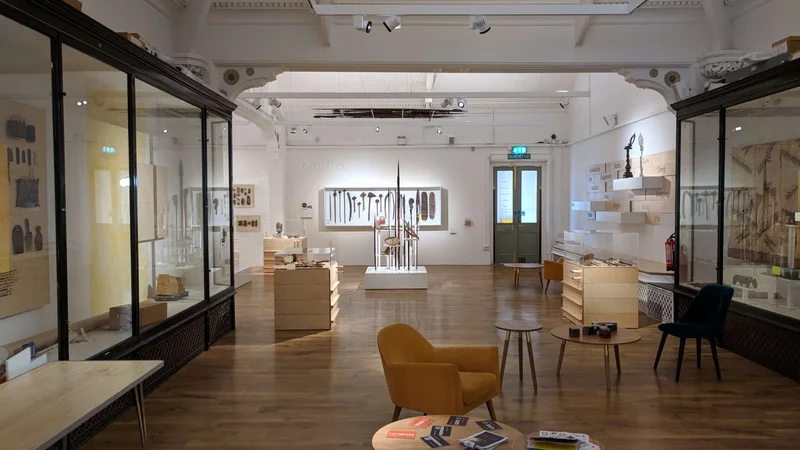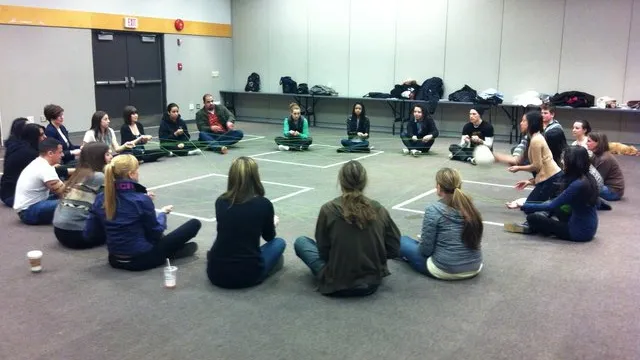Trauma-informed practice at museums is guided by five interconnected principles: safety, trust, belonging, empowerment, and empathy. These principles are not implemented once and completed but practiced continually. They shape how exhibitions are designed, how staff interact, how community partnerships are formed, how policies are written. They are the foundation on which all the specific strategies and skills rest.
Safety
Safety is the foundation of trauma-informed practice, though it cannot always be guaranteed. Ideally, visitors should encounter clear signage, welcoming staff, and transparent information. Whenever possible, content advisories should allow visitors to make informed choices, and visible exit points should reassure them they can step away. In practice, space and staffing constraints may limit these supports. The aspiration is steady progress toward greater safety.
Staff safety is equally important. Ideally, staff should have clear protocols, supportive supervisors, and opportunities to step away when needed. In reality, heavy workloads or competing priorities may reduce these supports. Recognizing these limits highlights the importance of embedding safety into planning and policy rather than treating it as optional or supplementary.
Safety in Practice
Example: A visitor becomes distressed in front of a residential school artifact. Ideally, a staff member notices, offers a nearby reflection space, and remains present. In practice, no staff may be available, or there might not be a nearby space for safe expression. The aspiration is to strengthen systems—through training, staffing, and design—that make the ideal response more likely.
Safety operates at multiple levels in museum contexts:
Physical safety – Accessible spaces, clear exits, appropriate lighting, freedom from physical threat. Visitors need to know where they are and how to leave. The architecture should not create situations where people feel trapped or disoriented.
Emotional safety – Predictability, choice, respect for boundaries, acknowledgment of responses. Visitors need to know what they're about to encounter and have some control over their engagement with it.
Psychological safety – Freedom from humiliation, coercion, or invalidation. Visitors' and staff's emotional responses need to be treated as legitimate rather than dismissed or judged.
Relational safety – Trust that others will respond with care. When visitors or staff express distress, they need confidence that the response will be supportive rather than dismissive.
Trust
Trust grows through transparency, honesty, and consistency. Ideally, signage should prepare visitors for difficult content, and staff should respond with steadiness. In practice, unclear communication or staffing pressures can undermine trust. The aspiration is to aim for transparency even in imperfect circumstances.
For staff, trust depends on leadership that models integrity and keeps commitments. In practice, deadlines may erode these commitments. Even so, acknowledging limits and admitting mistakes helps preserve trust. Trust is built slowly through many small interactions but can be damaged quickly through one instance of deception or inconsistency.
Trust in Practice
Example: A visitor reacts angrily to an exhibit on systemic racism. Ideally, staff listen without defensiveness, respond empathically, and explain the museum's role with calm honesty. In practice, staff may feel unprepared, harried, or distracted. The aspiration is to equip staff with training and support for these moments, and to create systems where it's safe to admit "I don't know" or "Let me find someone who can help."
Trust requires several elements:
Transparency – Being clear about what visitors will encounter, about institutional constraints, about how decisions are made. Museums cannot promise what they cannot deliver, but they can be honest about limitations.
Consistency – Following through on commitments. If a content advisory says there will be a quiet space nearby, that space must exist. If staff promise to follow up with a community partner, they must do so.
Honesty about mistakes – When something goes wrong, acknowledging it clearly rather than deflecting or minimizing. Trust is preserved not through perfection but through accountability.
Reliability over time – Trust cannot be rushed. It builds through repeated interactions where the museum demonstrates that its words align with its actions.
Belonging
Belonging means that visitors and staff feel welcomed and valued. Ideally, this is communicated through inclusive language and exhibitions that reflect diverse perspectives. In practice, resource limitations or entrenched norms may undermine belonging. Naming it as a principle helps keep it in focus.
Belonging is about more than representation. It's about whether people feel they can bring their full selves to the space—their questions, their emotions, their experiences—without judgment. It's about whether the environment signals This is a place for you or This is a place you may visit but where you don't really belong.
Belonging operates in multiple dimensions:
- For visitors – Whose stories are centered? Whose languages are used? Whose aesthetic preferences shape design? Who is assumed to be the "general" audience? Who has to have their existence explained or justified?
- For staff – Staff from affected communities may bring irreplaceable knowledge but are also more vulnerable to vicarious trauma. They should not be expected to represent their entire community or to be the only ones doing this work. Belonging means ensuring these staff members feel supported and that the labor of addressing historical trauma doesn't fall disproportionately on those most impacted by it.
- Beyond representation – Belonging also manifests in physical space. Is the building accessible? Do front-line staff reflect community diversity? Are there cultural or religious accommodations (prayer spaces, gender-neutral bathrooms)? Does the institution's tone feel inviting or intimidating? Can people see themselves in the museum's vision and values?
Empowerment
Empowerment involves offering agency and choice. Ideally, visitors should be able to regulate their engagement with content through alternate routes or advisories. In practice, architectural and budget constraints may reduce flexibility. Even so, staff can look for small ways to increase choice: offering a bench to rest, suggesting a different gallery if one is too intense, asking What would be helpful for you right now?
For staff, empowerment means discretion to respond with empathy and opportunities for growth. In practice, rigid policies may restrict flexibility. The aspiration is to advocate for systems that trust staff judgment and provide them with the skills and genuine authority to make decisions that prioritize care.
Empowerment restores a sense of control that trauma often takes away:
- Choice in engagement – Visitors choosing how deeply to engage with content, having multiple ways to interact with material (text, audio, visual, interactive), accessing information at their own pace, being able to leave and return as needed.
- Voice in process – Staff having input into project assignments, voice in how work is structured, permission to advocate for their needs without professional penalty, opportunities to shape institutional practices.
- Control over representation – Community partners having control over how their stories are told, power to approve or reject proposed content, ownership of intellectual and cultural property, ability to withdraw participation if trust is broken.
- Limits of empowerment – Not all choices can be offered. Museums have institutional constraints, legal requirements, and sometimes competing obligations. But empowerment requires being honest about constraints, offering meaningful choice where possible, explaining why certain choices aren't available, and working to shift structural barriers that limit empowerment.
Empathy
Empathy is the heart of trauma-informed practice, but it is not simple. Many staff have attended trauma-awareness workshops, but intellectual knowledge alone does not build empathy. Without ongoing reflection and practice, efforts can cause harm. Empathy requires humility, self-awareness, and personal healing. It is not a technique to be applied but a state of being to be cultivated.
Staff may mistakenly believe that knowing the basics of trauma equips them to intervene effectively. They may treat empathy as an outward action without cultivating inward steadiness. This is risky: a little knowledge can be dangerous. True empathy grows from within. It requires us to recognize and manage our own emotional undercurrents, to notice our biases and judgments, to practice grounding and presence, to maintain boundaries while remaining open.
The guide therefore emphasizes empathy as a continuous process. Ideally, staff should see empathy not as a one-time learning outcome but as an ongoing orientation. Whenever possible, staff should be encouraged to engage in self-reflection, mentorship, and peer support that deepen their ability to listen, remain present, and act with humility. Developing empathy involves learning to hold discomfort, to notice one's own emotional activation, and to cultivate steadiness even in the face of strong emotions—one's own and others'.
Empathy in Practice
Example: After an emotionally intense exhibition, a visitor becomes tearful. A staff member, freshly trained in trauma basics, may feel compelled to immediately comfort the visitor with words or advice. A more seasoned empathic response might involve pausing, noticing the visitor's state, and quietly offering presence without rushing to intervene. It looks like this has stirred up some strong feelings. I'm around if it would help to talk, or if you'd prefer some quiet, there's a space just around the corner. I can take you there. This difference—between outward action and inward steadiness—illustrates the depth of skill that true empathy requires.
Empathy involves several capacities:
- Presence without performance – Being genuinely present rather than performing care. People can sense when empathy is authentic versus when it's a technique being applied.
- Self-awareness – Recognizing our own emotional reactions so we don't amplify the dynamics between ourselves and others. Noticing when a visitor's story activates our own unresolved material.
- Boundaries – Empathy is not about merging with another person's pain or taking it on ourselves. It's about being present to their experience while remaining grounded in ourselves.
- Humility – Acknowledging that we don't fully understand another person's experience, that our perspective is limited, that we might be wrong in our assumptions.
- Sustained practice – Empathy is not a skill acquired once but a capacity cultivated through ongoing practice, reflection, and personal work.
How the Principles Work Together
These principles and practices don't operate in isolation. They're interdependent and mutually reinforcing:
- Personal connection facilitates belonging
- Belonging allows for trust (via empathy)
- Trust enables safety
- Safety facilitates empowerment
Strengthen one strand of this web and the whole structure becomes more resilient. Neglect one and the entire system weakens.
Principles as Practice
The test of these principles isn't whether you can articulate them—it's whether they show up in daily practice. Do they shape how you:
- Design an exhibition label?
- Respond when a visitor is crying?
- Structure a meeting with community partners?
- Allocate budget for staff mental health support?
- Make hiring decisions?
- Handle a mistake?
Principles become practice through thousands of small enactments. Each choice is an opportunity to either strengthen or weaken trauma-informed culture. This requires vigilance, but also grace. You will make mistakes. Institutions will fall short. The question isn't whether you'll always get it right—it's whether you have systems in place to notice when you don't, to take accountability, and to learn.
The Foundation for All That Follows
These five principles—belonging, trust, safety, empowerment, and empathy—are not abstract ideals but practical guides for daily work. They shape everything that follows in this series: how we support colleagues, how we design exhibitions, how we work with community partners, how we sustain practices over time. They are the compass that orients us when situations are complex and paths are unclear. They remind us that trauma-informed practice is not primarily about techniques or protocols but about values enacted through countless small choices, day after day, until they become the culture itself.
Next
Guide Navigation
The introductory page of the guide provides the context and rationale for trauma-informed museum practices and includes an overview of each page.
Understanding Trauma in Museum Contexts explores how trauma operates as a complex, ecological phenomenon affecting visitors, staff, and community partners. It examines the neuroscience of trauma responses, the patterns that emerge from person-environment interactions, and why museums need this foundational knowledge.
Considerations for Trauma-Informed Training addresses the personal dimension of this work—why trauma-informed training must be fundamentally different from typical professional development, how to build skills safely, and the importance of self-awareness and empathy as foundations for supporting others.
Core Principles of Trauma-Informed Practice outlines five interconnected principles—safety, trust, belonging, empowerment, and empathy—that guide all trauma-informed work. These are not implemented once but practiced continually, shaping how exhibitions are designed, how staff interact, and how partnerships are formed.
Supporting Colleagues examines what it means to care for one another in workplaces where exposure to traumatic content is routine. It explores the skills of presence, the importance of boundaries, and how to create a culture where supporting each other becomes ordinary rather than exceptional.
Trauma-Informed Exhibition Planning addresses the challenge of creating exhibitions that convey difficult truths with honesty while respecting visitor wellbeing. It offers practical strategies for content advisories, visitor choice, regulation spaces, and creative engagement that honors both truth-telling and care.
Working with Community Partners explores how to build genuine, reciprocal partnerships with communities whose traumatic histories museums represent. It emphasizes the importance of multiple sessions over time, incorporating creative work alongside discussion, and creating conditions where trust can develop.
Sustaining the Practice addresses how trauma-informed approaches become embedded in organizational culture rather than remaining isolated initiatives. It explores onboarding, documentation, leadership modeling, policy alignment, and the long-term work of creating environments where care is expected and practiced.



